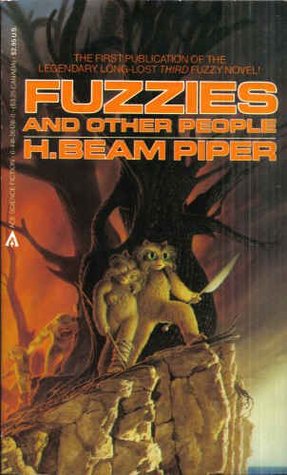H. Beam Piper
Completed 7/22/2018, Reviewed 7/22/2018
4 stars
This third book in the Fuzzy series was published twenty
years after the second book and the author’s death. The manuscript was found in his basement and
finally published in 1984. I loved it. It has the maturity of the second book with
the playfulness of the first. The story
continues right after the end of the second book. I believe all three of these books should be
read one after the other for the full effect.
The narrative of the book is a little different. While it follows the humans on the planet Zarathustra
and their experiences with the Fuzzies, it also follows a group of Fuzzies
still in the wild. I really liked this. It got us into the heads of the Fuzzies more
deeply than either of the first two books.
Warning: This being
the third book, this review will have some spoilers for the previous two books.
After the plot to steal the sunstones is foiled, the criminals
are caught and face trial. They have a
sharp lawyer who is trying to get them absolved from faginism and slavery
charges, which carries a death sentence.
Faginism, like Fagin from Dickens’ “Oliver Twist”, is the entrapment and
training of youths to commit crimes for the adults. This would hold because legally, the Fuzzies
are considered 10-12-year-old children and the criminals coerced the Fuzzies
into executing their plan to steal the sunstones. But if the lawyer can get this overturned, it
would throw the whole adoption of Fuzzies by humans into turmoil, and they
would lose a lot of their protections. In
the meantime, a group of Fuzzies still in the wild have a close encounter with
humans, known as Big Ones. The Wise One
of the group believes that Big Ones wouldn’t hurt them and wants to bring his
little group of eight to the south where they believe the big ones live. The story follows them in their travels as they
hunt for food and fight predators and the elements.
This secondary plot of the wild Fuzzies is what made the
book for me. It was great society
building, replete with Fuzzy language.
It exemplified how the Fuzzies lived before contact with humans. It shows them to be intelligent, though primitive,
and more than just smart pets, which is the feeling you get from the second
book.
This, like the other books, is short. It’s an easy read and very engrossing. The trilogy is well worth the read, if you
can find the third book. As of this
writing, it is not in e-book format. I
found it at Powell’s and it was the only copy they had. I’m so glad I found it. Now I think I’m suitably prepared to read
Scalzi’s reboot, “Fuzzy Nation”.

No comments:
Post a Comment